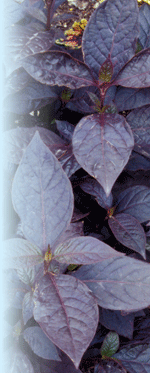Joseph’s Coat Enhances Other Colors
go.ncsu.edu/readext?234391
en Español / em Português
El inglés es el idioma de control de esta página. En la medida en que haya algún conflicto entre la traducción al inglés y la traducción, el inglés prevalece.
Al hacer clic en el enlace de traducción se activa un servicio de traducción gratuito para convertir la página al español. Al igual que con cualquier traducción por Internet, la conversión no es sensible al contexto y puede que no traduzca el texto en su significado original. NC State Extension no garantiza la exactitud del texto traducido. Por favor, tenga en cuenta que algunas aplicaciones y/o servicios pueden no funcionar como se espera cuando se traducen.
Português
Inglês é o idioma de controle desta página. Na medida que haja algum conflito entre o texto original em Inglês e a tradução, o Inglês prevalece.
Ao clicar no link de tradução, um serviço gratuito de tradução será ativado para converter a página para o Português. Como em qualquer tradução pela internet, a conversão não é sensivel ao contexto e pode não ocorrer a tradução para o significado orginal. O serviço de Extensão da Carolina do Norte (NC State Extension) não garante a exatidão do texto traduzido. Por favor, observe que algumas funções ou serviços podem não funcionar como esperado após a tradução.
English
English is the controlling language of this page. To the extent there is any conflict between the English text and the translation, English controls.
Clicking on the translation link activates a free translation service to convert the page to Spanish. As with any Internet translation, the conversion is not context-sensitive and may not translate the text to its original meaning. NC State Extension does not guarantee the accuracy of the translated text. Please note that some applications and/or services may not function as expected when translated.
Collapse ▲
‘Purple Knight’
Robert E. Lyons ©
Alternanthera ficoidea is an heirloom plant that was popular during the Victorian era in formal gardens, and has made its way into our annual gardens with several new cultivars from Mexico and South America. Joseph’s coat is the common name for this plant, but it is sometimes confused with a yellow green form of summer poinsettia that is also called Joseph’s coat. Landscapers call the plant chartreuse alternanthera to avoid the common name confusion. It is also called golden parrot leaf, golden alternanthera or chartreuse calico plant.
Chartreuse alternanthera has eye-catching yellow green foliage, compact growth habit, durability and nonstop color from early spring until fall frost. The growth habit is 4 to 8 inches tall and 6 to 12 inches wide. It is often used in formal knot gardens or as edging to define plant beds. The plant enhances or echoes other colors, making them appear more vibrant. Alternanthera is grown for its foliage. Its small, greenish white flower is borne in the leaf axis and hidden by the foliage. Chartreuse alternanthera does best in full sun with moist, well-drained soils. Light pinching will keep plants compact.

Chartreuse Alternanthera
Robert E. Lyons ©
Alternanthera dentata ‘Purple Knight’ is a frost-tender perennial grown for its dark purple foliage and can be used as a beautiful contrast against other plants in less formal beds and flower borders. The rich color is only produced in full sun and makes a dramatic accent in sunny gardens. To maintain a compact habit, regularly pinch out the growing tips. To keep a formal appearance, use pruning shears to trim the plants in summer. Plant in well-drained soil; water regularly during summer. The growth habit is 18 to 36 inches in height with an equal spread. The purple leaves excel in high heat and humidity. This plant looks great with rudbeckia and lantana.
Look for Alternenthera during summer in the entrance garden at the JC Raulston Arboretum. This planting, of mainly tropical annuals and tender perennials, is a celebration of color, texture and form.
Amy-Lynn Albertson


